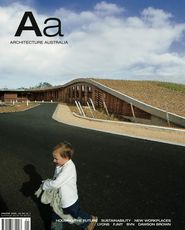WHY IS IT that women, who in 2002 comprised 43 per cent of architectural students, make up less than 1 per cent of the company directors of architectural practices in Australia? Part of this discrepancy may be viewed as a “time lag” problem - women are relatively new to the profession and in time their representation in senior positions is expected to increase. However, this “time lag” only partly explains the current under-representation of women within the upper ranks of the architectural profession.
Earlier this year, the Institute wrote to all female architects and graduates who are members of the RAIA, seeking their input to a survey conducted by Dr Paula Whitman, President of the Queensland Chapter and a Senior Lecturer in the School of Design at the Queensland University of Technology, to address this question. From the 1,120 surveys distributed, 550 responses were received, achieving a return rate of 49 per cent - an excellent response for this type of survey.
The findings of Paula’s survey make interesting reading.
While the majority of respondents indicated that they have a high level of satisfaction with their current role and feel that they have control over their professional activities, a majority also indicated that they have (or would) sacrifice career progression for the sake of achieving “balance” in their lives. About 60 per cent of those surveyed indicated that they have declined offers to take more senior roles within practices because they have different career aspirations and more that 50 per cent said the promotion would not give them increased satisfaction in their work.
This led to consideration of how success is measured by those responding to the survey. For the majority, personal satisfaction and client satisfaction were considered to be the most meaningful measures of success. One quote from a respondent sums up this attitude: “I work stupid hours and have at times compromised my personal life, however this is not because I am thinking of success in my career, but that I have a commitment to doing the job at hand well … job satisfaction [is] a major priority, which I try to balance with my personal life.” However, the survey also revealed a low level of satisfaction among women with regard to their current remuneration, present rate of career progress and long-term career opportunities. As a result, two thirds said their major goal was to set up their own practice, and by doing so, it was hoped that they might be able to control their own life more effectively. The perception was that this would allow them greater autonomy.
One of the basic assumptions underlying this survey is that career progression is measured by whether one becomes a director of an architectural practice. The survey recognized that this assumption is contestable. Yet, if a directorship is one of a range of desired goals, the greatest barriers to career progression experienced by the women who responded to this survey included family commitments, lack of time and poor relationships within the industry.Women also rejected indicators such as the scale of a project, the size of an architectural practice, the number of awards and amount of journal coverage as measures of their personal success, but believe that the profession generally values these factors as indicators of career achievements.
Another major issue addressed in the survey was the anecdotal reporting that many women have a “discontinuous” pattern of employment, moving in and out of architectural practice and the profession. The survey found this to be the case, with 63 per cent of the women having taken a break during their last five periods of employment. These breaks range from three months to 24 months. The most common reasons for taking breaks were family commitments followed closely by travel and study leave. Leave to raise children and fulfil family commitments generally ranged from six to 24 months, while travel leave generally only lasted up to six months. Study leave was mostly around 12 months in duration. The high incidence of periods of leave suggests that women do, indeed, have a discontinuous career pattern, spending significant amounts of time away from employment within the profession.
As with most of the findings of this study, it is not possible to compare this employment pattern with those of males within the profession, as no such data exists for the male cohort. To make the most use of the findings from this survey, a similar survey of male architects would provide valuable feedback for determining strategies on how the profession can best address the issues raised for both women and men.
Paula’s survey is an excellent first step in addressing these important issues for the architectural profession. To ensure that they are progressed, the Institute has now established a Working Party to consider the issues raised and to ensure that the Institute is responding to the career needs of its female members.
I hope that, through Paula’s initiative, the important contribution of women to the architectural profession can be enhanced and more ably facilitated through a range of actions to be promoted by the RAIA.
Warren Kerr FRAIA, HONAIA
National President RAIA















